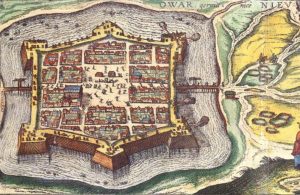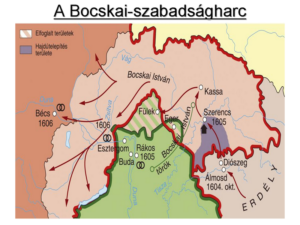The Long War, Part 37 / The heydays of Bocskai, 1605

The fall of Esztergom castle, 3 October 1605
The tragic fall of Esztergom is said to be connected with Bocskai’s alliance with the Turks: no wonder that Bocskai felt “haunted” by it. The recapture of Esztergom in 1595 was one of the greatest successes of the 15 Years’ War for the Christian forces. It was a long and arduous siege, but the fortress had to be taken as it was a very important castle in the defense of Buda, the old capital of Hungary.

The Sublime Porte tried everything to regain this strategic place. The Turks were even willing to exchange it for the castle of Eger or Kanizsa. However, they did not have a chance to besiege Esztergom during the war, and the first time they could do so was in 1604. The siege took place between September 19 and October 13, but the Christians defended themselves well and defeated the army led by Grand Vizier Lala Mehmed. Read more about it here:
By the time the siege was finally over, Prince Bocskai’s revolt was underway and he conquered all of Upper Hungary before the end of 1605. Naturally, the Porte took advantage of the Habsburgs’ current distress and attempted to take Esztergom in the autumn of 1605. General Basta had 8,000 men, but they weren’t enough to relieve Érsekújvár, which was besieged by Bocskai, and Basta couldn’t bring reinforcements to the besieged Esztergom.

The captain of Esztergom, Adolf of Althan, had recently resigned, leaving the castle without a leader. Wilheim Öttingen took over the leadership and was in command of about 5-6,000 soldiers. Prince Bocskai was not happy with the Turkish siege of Esztergom and he refused any help from the Turkish Serdar (General). Read more about Bocskai here:
https://www.hungarianottomanwars.com/essays/prince-bocskai-istvan/

Öttinger didn’t trust the Hungarian soldiers, so he let them go before the siege. These Hungarians had nowhere to go but to join Bocskai in the siege of Érsekújvár. The Ottoman army reached Esztergom on August 30th. Before the siege was over, Count Dampierre and his five battalions escaped from Komárom Castle and brought reinforcements to Esztergom.
The increased numbers in the fortress were just enough to guard the inner walls and the long outer ramparts, the fortress on St. Thomas Hill, and the town on the Danube.

The Germans strongly defended the fort and repulsed the attack that targeted Saint Thomas Hill on September 8. Despite their steadfastness, the Turks surprised the Christian soldiers at dawn on September 16 and slaughtered all the guards of the Saint Thomas fort. This important fortification fell. Soon the rest of the ramparts fell as well. The rest of the guards (about 5,000 men) retreated to the inner castle.
Then, the Turks started firing their cannons at the walls of the city. After this, they launched an attack on October 1. The Germans suffered huge losses and withdrew from the city, all of them moved to the inner castle. About 1,000 of them died defending the town. Richan, the vice-commander of Öttingen, also lost his life there.
The commander became Count Dampierre.

The Turks dug mines under the walls and the castle buildings caught fire, killing many Germans. The German guards began to demand that Dampierre surrender the castle, but he refused. Finally, they ceded the castle, and the defenders were allowed to leave the town and keep their weapons. The strange thing was that the captor of Esztergom was the same Pasha Lala Mehmed who had been forced to surrender the castle ten years before.

Among the members of the negotiating committee was Pecevi Ibrahim (who was born in Pécs, Hungary), who had been one of the signatories of the document that changed the ownership of the castle ten years ago. We know that the father of the famous Turkish historian Cselebi fought among the besiegers. His name was Dervis Mehmed Zillin. The Germans, who retreated to the Komárom fort, were disarmed and imprisoned upon their arrival. Captain Leonhad Friedrich Schlöcker was sentenced to have his tongue and arms cut off and to be hanged, and 24 other soldiers were also hanged. The names of those who sided with the enemy were nailed to the gallows, indicating the fate that awaited them if they were captured. Dampierre was later pardoned.

The Ottomans left three “oda” (3,000) Jannisaries to guard Esztergom. They were forbidden to leave the city. However, there were the soldiers of Kapudan Pasha, the irregular marauders who regularly patrolled the area and plundered the Christian villages. According to Cselebi, these soldiers dressed like Hungarians and spoke the Hungarian language. Their raids reached the lands of Germany. As for Esztergom, the song of the muezzin was heard again for many years; the local Hungarians simply called him “skin-bell” (bőrharang).
Autumn 1605 – The heydays of Prince Bocskai
Having taken Esztergom Castle, the army of Pasha Lala Mehmed appeared at Érsekújvár (Nové Zámky) where they joined the camp of the rebels. His appearance has made the defenders of Érsekújvár hurry to surrender the fort. Finally, they could achieve that only the Hajdú soldiers entered the city while the Turks had to remain outside.

The famous meeting of Rákosmezeje (at Pest) was the next event where Pasha Lala Mehmed handed the crown sent by the Sultan to Bocskai. The sources are divided regarding whether Bocskai had accepted or refused it. His symbolical coronation most likely had taken place but the diplomats (like Bocatinus János who wrote it down) around the Prince wanted to make it appear before the Habsburgs as the Prince had received the crown only as a gift.

After this, Bocskai summoned the Estates to Korpona because he wanted to make a truce with the Habsburgs as well. He knew that Hungary could get help against the Turks only from the Habsburgs in case of peril. At the same time, the Transylvanian Principality would be stronger if he could get some more northern counties from Royal Hungary. A powerful Transylvania would be able to defend the constitutional rights of the Hungarian Estates of Royal Hungary against the Habsburgs.
The Diet began on 24 November but there were plenty of debates about the future. The radicals, led by Bocskai`s chancellor Kátay Mihály would have welcomed a Protestant ruler from abroad on the Hungarian throne and they were against the truce with the Habsburgs. In favor of them, the Estates made more laws that served the interests of the Protestants. Here I have to note that the whole uprising was originally related to the Habsburgs because they had been persecuting the Protestants and were busy filling their Treasury with the wealth taken away from the richest Hungarian lords.

The Diet ruled about the election of a Palatine (according to this ancient rank which had existed in the Hungarian Kingdom, he was the substitute of the Hungarian king who ruled on his behalf if the king was not within the borders of Hungary). Also, they decided to make peace with the Turks. Bocskai issued a donation letter on 12 December and he settled 10,000 Hajdú soldiers in the towns of Bihar County, giving them so-called „collective nobility”.
After the decisions of the Diet, the negotiations with the Court of Vienna and Prague began, led by Lord Illésházy.
3 December 1605: The mercenaries of General Basta defeat Prince Bocskai`s troops at Rábahídvég
Hajdú-captain Gergely Némethy had led two campaigns to conquer the Trans-Danubian Region of Royal Hungary in 1605. During the military actions from May to the end of June, the rebels of Bocskai had taken almost the entire West- and Middle-Trans-Danubian Region, except Sopron Castle and a few castles on the Austrian border. Yet, the Imperials struck back in July-August and forced Captain Némethy from this part of the country but he turned back at the end of August.

His Hajdú troops were not as successful as before and he could hardly enlarge their numbers. He didn`t have enough power to besiege castles, he was just raiding around. Still, he could scatter the 800 mounted riflemen of Alexander Ridolphi at the end of September near Szombathely.

The Imperial counter-attack was launched in October and he has been gradually pushed out from the area that lay west of the Rába River, even though the rebels were supported by Turkish and Crimean Tatar troops. The beginning of December found the Imperial and the Hajdú troops facing each other on the opposite banks of the Rába River. It was the location where Prince Bocskai`s last Trans-Danubian clash took place.

Arch-Duke Matthias wrote the following to the Archbishop of Mainz on 14 December:
„The enemy, namely 300 Tatars, 100 Turks, and 200 Hungarian rebels attacked our camp at Hídvég between Szombathely and Körmend on 3 December, and they had been fighting against our Serbian soldiers for a long time. Finally, Basta has come to their help with his Walloons and other folks. The enemy, with the help of God, was forced back to the Rába River, 200 were slain and many of them drowned in the water or got captured. Two Walloon companies took over the chase but the enemy didn`t stop his running. Count Valle had fallen in these fights, by getting into a throng during the chase and was killed by a shot. Besides the captured enemy, we got hold of 1,500 Tatar horses. Now, our camp is at Egervár Castle, 5 miles from Kanizsa Castle.”

The Hungarian chronicler Istvánffy added to this: „The whole army has been extremely saddened that Prince Fridericus Holstainius, a young lad, captain of 1,000 riders, fell in the fight. He was dressed up in gilded armor and had shining weapons in his hands, wearing a gold helmet on his head, in a gold color leather riding trousers, and noticing him, the enemy killed his horse with arrows, then he was pulled to the ground. As his body was sheltered all over with iron, they thrust a handjar (a curved Turkish dagger) between his last rib and his groins.”
According to other sources, the number of Turkish-Crimean Tatar troops was tenfold than mentioned above.
In fact, this defeat was the end of the uprising in the Trans-Danubian Region. Némethy fled to the Ottoman Occupied Lands, then returned to Prince Bocskai. Others, like Nádasdy Tamás, did the same, while Hagymássy Kristóf closed himself into Szentgrót Castle. Only the Castle of Tata remained faithful to Bocskai in the region.
Source: Szibler Gábor
Dear Readers, I can only make this content available through small donations or by selling my books or T-shirts.
If you like my writings, please feel free to support me with a coffee here:
You can check out my books on Amazon or Draft2Digital, they are available in hardcover, paperback, or ebook:
https://www.amazon.com/dp/198020490X
or at https://books2read.com/b/boYd81


My work can also be followed and supported on Patreon: Become a Patron!http://Become a Patron!



